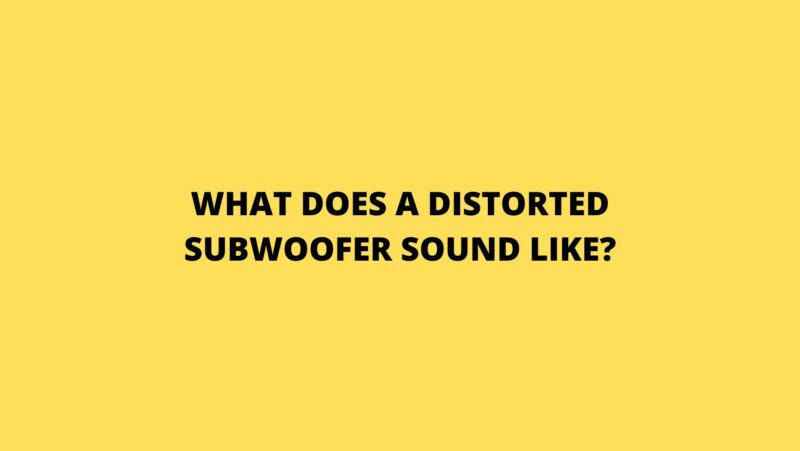Subwoofers, the rhythmic pulse of audio systems, infuse music and movies with the visceral impact of low-frequency tones. However, even these powerful components can fall prey to distortions, altering the harmonious soundscape. A distorted subwoofer can mar the clarity and resonance of audio, diminishing the overall listening experience. But how can you recognize the elusive signs of a distorted subwoofer amidst the intricate melodies? In this article, we embark on a journey to explore what a distorted subwoofer sounds like, dissecting the auditory clues that unveil its presence and the steps you can take to diagnose and rectify this issue.
The Symphony of Disruption: Unmasking the Sounds of a Distorted Subwoofer
A distorted subwoofer doesn’t merely emit a single, jarring sound—it introduces a symphony of imperfections that can erode the richness of the audio landscape.
Decoding the Auditory Indicators
Unraveling the sounds of a distorted subwoofer requires attuning your ear to the subtleties of sonic decay. Here are the auditory cues that might signify a distorted subwoofer:
1. Muddiness and Murkiness
One of the most palpable signs of a distorted subwoofer is a sense of muddiness and murkiness in the bass frequencies. Instead of rendering deep, resonant tones, a distorted subwoofer might introduce a vague and unclear quality to the bass, lacking the crispness and definition that characterize undistorted bass tones.
2. Harsh Clipping and Cracking Noises
A distorted subwoofer can generate harsh clipping and cracking sounds when pushed to its limits. Clipping occurs when the subwoofer’s amplifier attempts to deliver more power than it can handle, resulting in distorted and unpleasant noises. These noises can be particularly noticeable at higher volume levels.
3. Unwanted Vibrations and Rattling
Distorted subwoofers can introduce unwanted vibrations and rattling noises in their enclosures or nearby objects. These vibrations are often caused by the subwoofer’s cone or other components moving erratically due to the stresses of distortion.
4. Inconsistent Bass Output
If you notice fluctuations in the subwoofer’s bass output—such as sudden drops or surges in volume—it might point to distortion issues. Distorted subwoofers struggle to deliver consistent and balanced bass frequencies, leading to irregularities in the sound output.
5. Reduced Impact and Presence
A distorted subwoofer may lack the impactful and authoritative presence that characterizes well-tuned bass. Instead of creating a visceral sensation, a distorted subwoofer might produce weak and feeble bass notes that fail to resonate with the listener.
6. Impaired Harmonic Overtones
Distorted subwoofers often struggle to reproduce the harmonic overtones present in clean bass notes. As a result, the bass tones can sound flat and one-dimensional, devoid of the rich harmonics that add depth to the sound.
Steps to Diagnose and Address Distortion
Recognizing the signs of distortion in a subwoofer is the first step toward resolving the issue. Here’s how you can diagnose and potentially rectify the problem:
1. Visual Examination
Inspect the subwoofer for visible damage such as tears or punctures in the cone, loose wires, or signs of wear and tear. Visual cues can provide insights into the potential causes of distortion.
2. Check Amplifier Settings
Examine the settings of the subwoofer’s amplifier. Ensure that the amplifier’s gain, crossover, and equalization settings are appropriately configured to match the subwoofer’s specifications.
3. Test Different Audio Sources
Play different audio tracks to determine if the distortion is consistent across various sources. If the distortion persists regardless of the source, it’s more likely that the subwoofer itself is the source of the problem.
4. Adjust Bass Levels
Experiment with adjusting the bass levels in your audio system. If reducing the bass level alleviates the distortion, it could indicate that the subwoofer is being driven too hard and requires adjustments in its setup.
5. Seek Professional Evaluation
If you’re unable to diagnose the distortion or if the subwoofer’s condition seems severe, consider seeking the expertise of a professional audio technician. They can conduct comprehensive tests to determine the extent of the distortion and recommend appropriate solutions.
Conclusion
A distorted subwoofer introduces a discordant note into the symphony of sound, altering the texture and resonance of the audio landscape. Recognizing the auditory indicators of distortion empowers you to take proactive measures to diagnose and potentially resolve the issue. By training your ear to the subtleties of sonic imperfections and taking strategic steps to address distortion, you can restore the purity and vibrancy of your audio experience. As you navigate the realm of audio aesthetics, let this knowledge guide your pursuit of sonic excellence, where even the slightest distortions can be uncovered and harmonized into a harmonious soundscape.


